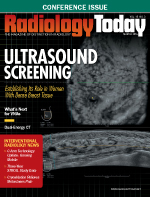 March 2014
March 2014
Big Changes for Vascular Embolization
By Leslie Bargfrede, CPC, CIRCC, RCC
Radiology Today
Vol. 15 No. 3 P. 25
As has been the evolution over the past several years, reporting individual components for interventional radiology procedures appears to be moving toward extinction, and this year is no exception.
In 2006, the American Medical Association’s Relative Value Scale Update Committee (RUC) created the Five-Year Review Identification Workgroup (now known as the Relativity Assessment Workgroup). Its purpose is to identify potentially misvalued services as well as develop and maintaining the new technology services.
Currently, one task for the CPT-RUC Joint Workgroup is to evaluate code pairs performed at a frequency of 75% or more to identify pairings of services that should be bundled together. In interventional radiology, when these new comprehensive codes are created, they typically will include components such as imaging guidance, radiologic supervision and interpretation, and selective catheterization and/or completion angiography.
As has been evidenced year after year with what seems to be the endless creation of bundled codes, the RUC finds this approach to be successful.
Bundled Codes
One major change this year occurs with the vascular embolization and occlusion codes. These new bundled codes apply to anatomical sites other than the central nervous system (intracranial, spinal cord) and the noncentral nervous system (head and neck).
An interesting twist with the creation of these codes is that they’re driven based on the condition to be treated. These codes can be used for a wide range of clinical indications and in many different vascular territories. One key point is that these embolization codes don’t apply to varicose vein treatments. They can’t be used for ablation or sclerotherapy procedures of the extremities or skin for venous insufficiency. The following four new code options are available for embolization and occlusion:
• 37241, Venous system for treatment of conditions other than hemorrhage or tumor;
• 37242, Arterial system for treatment of conditions other than hemorrhage or tumor;
• 37243, For treatment of tumors, organ ischemia, or infarction; and
• 37244, Arterial or venous hemorrhage or lymphatic extravasation.
The first code, for the venous system, is used for treating venous conditions such as venous malformations, capillary hemangiomas, varicoceles, and visceral varices. The second code option, for the arterial system, applies to arteriovenous malformations and arteriovenous fistulas, aneurysms, and pseudoaneurysms.
The third code, for tumors, can be performed in many clinical scenarios, such as the treatment of uterine fibroids and benign or malignant tumors or the administration of chemotherapy or a radioisotope as part of an embolization procedure.
And finally, the last code is for treating hemorrhage or lymphatic extravasation, such as gastrointestinal bleeds, traumatic hemorrhage of the viscera or pelvis, or bronchial embolization for treatment of hemoptysis.
By bundling these procedures, the codes now include all associated radiological supervision and interpretation, intraprocedural guidance and road mapping, and imaging necessary to document the completion of the procedure. However, catheter placements and diagnostic angiography may be reported separately. As always, the diagnostic angiography guidelines supporting medical necessity must be met in order to report a separate diagnostic study.
A positive note with these changes is the treatment of uterine fibroids. According to the new criteria, the old uterine fibroid embolization code has been deleted, making selective catheterizations of the uterine and/or ovarian arteries now separately reportable. These were previously bundled into a single comprehensive code.
Many of the same guidelines apply to using these new embolization options, such as the rule that only one embolization code should be reported for each surgical field. If separate surgical fields are treated during a single session, multiple embolization codes may be applied.
One new distinction has been addressed for performing an embolization procedure when overlapping conditions exist. When this occurs, the code for the immediate indication/current symptoms for the embolization is applied. Treatment of a hemorrhage specifically supersedes embolization for all other conditions.
In Conclusion
With the groups diligently at work, we can expect to see this bundling trend continue for the foreseeable future. Physicians are strongly encouraged to communicate with their specialty societies and provide a voice during the development process and open comment period.
— Leslie Bargfrede, CPC, CIRCC, RCC, is a corporate coding specialist in interventional radiology with Zotec Partners.

